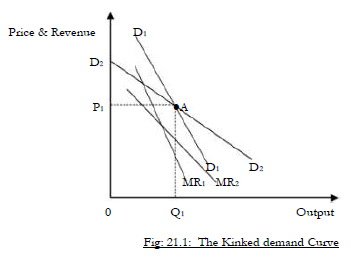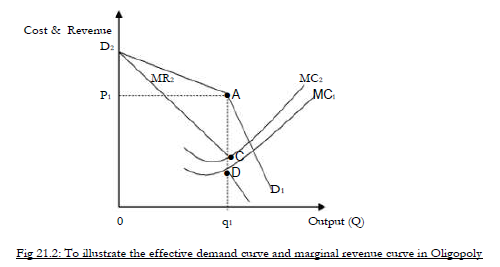The model for oligopoly that explains why prices are sticky downwards is the kinked demand curve
model.

Suppose that the oligopolist was selling a quantity of OQ1 at the price of OP1. Based on past experience, the
oligopolist expects that if he lowers his price, his rivals would also reduce their price in order to maintain their
market share. Thus below price OP1 the oligopolist faces a relatively price inelastic demand curve (AD1 ). A
proportionate fall in price below OP1 will lead to a less than proportionate increase in quantity demanded.
Also the oligopolist believes that when he increases his price, his rivals will keep their prices constant so as to
increase their market share thus above price OP1 the oligopolist faces a relatively elastic demand curve (AD2 ).
A proportionate increase in price above OP1 will lead to a more than proportionate fall in the quantity
demanded. The oligopolist thus, has two demand curves D1 D1 and D2 D2. . D1 D1 is the relatively inelastic
demand curve when the oligopolist expects his rivals to match his price changes and D2 D2 when he does not
expect his rivals to react.
For a straight line demand curve, marginal revenue curve lies halfway between the demand curve and the Yaxis.
The corresponding marginal revenue curves are MR1 and MR2 respectively. The effective demand curve (D2
AD1 ) and the marginal revenue curve facing the oligopolist is illustrated in the diagram below:

The effective demand curve is D2 AD1 . It is referred to as a kinked demand curve since it is kinked at point
A. The effective marginal revenue curve is given by D2 CDMR1 with a discontinuity between C and D.
Since the firm is at equilibrium with the output of Oq1 and price Op1, marginal cost curve cuts (intersects) the
marginal revenue curve somewhere in the area of discontinuity.
Changes in the firm?s marginal cost are possible (from MC1 to MC2) which will not induce the firm to
change its price.
Also possible are the changes in the market demand which shift the demand curve in and out without
affecting the height of the kink.
In short, changes in costs and revenue over a certain range will not affect the equilibrium price. The firm can
easily reduce the price but it is very hard to increase the price since if it increases, it will lose a big proportion
of its market share. The price therefore remains sticky once reduced, that is, all other firms will follow suit
and reduce but none will increase the price.
Wilfykil answered the question on
February 6, 2019 at 08:35